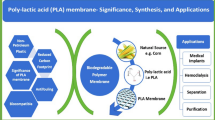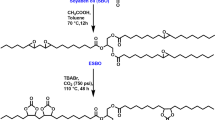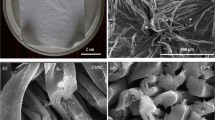Abstract
Superhydrophobic cotton fabric was prepared by coating fluorine-free cationic polyhedral oligomeric siloxane/polydimethylsiloxane-modified polyacrylate emulsion using the pad-bath method. Due to the successful introduction of heptaoctylmethacryloxypropyl polyhedral oligomeric siloxane and monovinyl polydimethylsiloxane, the film with a rough structure and low surface energy was formed on the cotton fabric surface, exhibiting excellent superhydrophobicity with a water contact angle of 161°. Additionally, the finished cotton fabric showed exceptional self-cleaning and anti-foiling abilities. The finished cotton fabric had a separation efficiency of over 97% for oil–water mixtures and maintained a high separation efficiency of over 96% after 20 cycles of separating the n-hexane/water mixture. In addition, the separation of different water-in-oil emulsions was achieved by overlapping three layers of finished cotton fabric. This suggests that the as-prepared superhydrophobic cotton fabric will be a promising material in application for treating oil–water mixtures and water-in-oil emulsions due to the low-cost, simple fabrication method and the superior separation capabilities.
Graphical abstract

















Similar content being viewed by others
Data availability
Data will be made available on request.
References
Peng Y, Liu Y, Dai J, Cao L, Liu X (2020) A sustainable strategy for remediation of oily sewage: clean and safe. Sep Purif Technol 240:116592. https://doi.org/10.1016/j.seppur.2020.116592
Vsquez L, Dziza K, Loo S, Binas V, Stefa S, Kiriakidis GA, Athanassiou DF (2022) Highly performant nanocomposite cryogels for multicomponent oily wastewater filtration. Sep Purif Technol 303:122252. https://doi.org/10.1016/j.seppur.2022.122252
Zhang R, Zhou Z, Chang Z, Dai X, Chen L, Dai J (2021) Superhydrophilic, underwater superoleophobic and self-cleaning nickel composite mesh via simultaneous acid etching and in-situ growth of Prussian blue analogue for oil-water separation. Colloids Surf A Physicochem Eng Aspects 627:127140. https://doi.org/10.1016/j.colsurfa.2021.127140
Liu M, Chen J, Cai X, Han Y, Xiong S (2018) Oil–water pre-separation with a novel axial hydrocyclone. Chin J Chem Eng 26(1):60–66. https://doi.org/10.1016/j.cjche.2017.06.021
Abidli A, Huang Y, Park C (2020) In situ oils/organic solvents cleanup and recovery using advanced oil-water separation system. Chemosphere 260:127586. https://doi.org/10.1016/j.chemosphere.2020.127586
Al-Maas M, Hussain A, Matar J, Ponnamma D, Hassan M, Maadeed M, Alamgir K, Adham S (2021) Validation and application of a membrane filtration evaluation protocol for oil-water separation. J Water Process Eng 43:102185. https://doi.org/10.1016/j.jwpe.2021.102185
Abdullahi B, Ahmed E, Abdulgader H, Alghunaimi F, Saleh T (2020) Facile fabrication of hydrophobic alkylamine intercalated graphene oxide as absorbent for highly effective oil-water separation. J Mol Liq 325:115057. https://doi.org/10.1016/j.molliq.2020.115057
Li R, Rao L, Zhang J, Shen L, Xu Y, You X, Liao B, Lin H (2021) Novel in-situ electroflotation driven by hydrogen evolution reaction (HER) with polypyrrole (PPy)-Ni-modified fabric membrane for efficient oil/water separation. J Membr Sci 635:119502. https://doi.org/10.1016/j.memsci.2021.119502
Kundu P, Mishra IM (2013) Removal of emulsified oil from oily wastewater (oil-in-water emulsion) using packed bed of polymeric resin beads. Sep Purif Technol 118:519–529. https://doi.org/10.1016/j.seppur.2013.07.041
Saththasivam J, Loganathan K, Sarp S (2016) An overview of oil-water separation using gas flotation systems. Chemosphere 144:671–680. https://doi.org/10.1016/j.chemosphere.2015.08.087
Yang J, Long F, Wang R, Zhang X, Yang Y, Hu W, Liu L (2021) Design of mechanical robust superhydrophobic Cu coatings with excellent corrosion resistance and self-cleaning performance inspired by lotus leaf. Colloids Surf A Physicochem Eng Aspects 627:127154. https://doi.org/10.1016/j.colsurfa.2021.127154
Luan K, He M, Xu B, Wang P, Zhou J, Hu B, Jiang L, Liu H (2021) Spontaneous directional self-cleaning on the feathers of the aquatic bird anser cygnoides domesticus induced by a transient superhydrophilicity. Adv Funct Mater 31:2010634. https://doi.org/10.1002/adfm.202010634
Han Z, Fu J, Wang Z, Wang Y, Li B, Mu Z, Zhang J, Niu S (2017) Long-term durability of superhydrophobic properties of butterfly wing scales after continuous contact with water. Colloids Surf A Physicochem Eng Asp 518:139–144. https://doi.org/10.1016/j.colsurfa.2017.01.030
Zhang Z, Wang H, Liang Y, Li X, Ren L, Cui Z, Luo C (2018) One-step fabrication of robust superhydrophobic and superoleophilic surfaces with self-cleaning and oil/water separation function. Sci Rep 8:3869. https://doi.org/10.1038/s41598-018-22241-9
Huang W, Huang J, Guo Z, Liu W (2022) Icephobic/anti-icing properties of superhydrophobic surfaces. Adv Colloid Interface Sci 304:102658. https://doi.org/10.1016/j.cis.2022.102658
Xin L, Li P, Li H, Sun W, Zhang C, Zhang K, Yin X, Yu S (2023) Fabrication of decoupling coatings with robustness and superhydrophobicity for anti-icing and anti-corrosion applications. J Mater Sci 58(13):6038–6054. https://doi.org/10.1007/s10853-023-08410-w
Pang Y, Yu Z, Chen H, Xiang Q, Wang Q, Xie C, Liu Y (2022) Superhydrophobic polyurethane sponge based on sepiolite for efficient oil/water separation. J Hazard Mater 434:128833. https://doi.org/10.1016/j.jhazmat.2022.128833
Pan G, Xiao X, Ye Z (2019) Fabrication of stable superhydrophobic coating on fabric with mechanical durability, UV resistance and high oil-water separation efficiency. Surf Coat Technol 360:318–328. https://doi.org/10.1016/j.surfcoat.2018.12.094
Zhao M, Tao Y, Wang J, He Y (2020) Facile preparation of superhydrophobic porous wood for continuous oil-water separation. J Water Process Eng 36:101279. https://doi.org/10.1016/j.jwpe.2020.101279
Yang Y, Zhao X, Ye L (2023) Facile construction of durable superhydrophobic cellulose paper for oil-water separation. Cellulose 30(5):3255–3265. https://doi.org/10.1007/s10570-023-05074-2
Bayram F, Mercan E, Karaman M (2021) One-step fabrication of superhydrophobic-superoleophilic membrane by initiated chemical vapor deposition method for oil-water separation. Colloid Polym Sci 299:1469–1477. https://doi.org/10.1007/s00396-021-04870-1
Barthwal S, Barthwal S, Singh B, Singh N (2020) Multifunctional and fluorine-free superhydrophobic composite coating based on PDMS modified MWCNTs/ZnO with self-cleaning, oil-water separation, and flame retardant properties. Colloids Surf A Physicochem Eng Aspects 597:124776. https://doi.org/10.1016/j.colsurfa.2020.124776
Zeng Z, Liu Y, Long L, He J, He Y, Wang L, Yang G, Zhang X, Shen F (2022) Fabrication of novel superhydrophilic/underwater superoleophobic composite coatings and study on the relationship between their long-term wettability and excellent oil-water separation performance. Surf Coat Technol 434:128193. https://doi.org/10.1016/j.surfcoat.2022.128193
Li X, Chen L, Feng D, Weng D, Wang J (2020) Thermally induced, tension-gradient-driven self-assembly of nanoparticle films for superhydrophobicity and oil-water separation. Cell Rep Phys Sci 100220:2666–3864. https://doi.org/10.1016/j.xcrp.2020.100220
Cao M, Xiao F, Yang Z, Chen Y, Lin L (2022) Construction of polytetrafluoroethylene nanofiber membrane via continuous electrospinning/electrospraying strategy for oil-water separation and demulsification. Sep Purif Technol 287:120575. https://doi.org/10.1016/j.seppur.2022.120575
Pintossi D, Colombo A, Levi M, Dragonetti C, Turri S, Griffini G (2017) UV-curable fluoropolymers crosslinked with functional fluorescent dyes: the way to multifunctional thin-film luminescent solar concentrators. J Mater Chem A 19:C7TA01692A. https://doi.org/10.1039/c7ta01692a
Pielichowski K, Njuguna J, Janowski B, Pielichowski J (2006) Polyhedral oligomeric silsesquioxanes (POSS)-containing nanohybrid polymers. Adv Polym Technol 201:225–296. https://doi.org/10.1007/12_077
Pi P, Hou K, Wen X, Xu S, Cheng J, Xu G, Wang S (2016) A facile one-step fabrication of robust superhydrophobic/superoleophilic cotton fabric using a crosslinkable POSS-containing fluorinated copolymer. Prog Org Coat 101:522–529. https://doi.org/10.1016/j.porgcoat.2016.09.023
Li H, Miao S, Chen W, Yang X, Li M, Xing T, Zhao Y, Chen G (2021) Durable superhydrophobic and oleophobic cotton fabric based on the grafting of fluorinated POSS through silane coupling and thiol-ene click reaction. Colloids Surf A Physicochem Eng Aspects 630:127566. https://doi.org/10.1016/j.colsurfa.2021.127566
Liang F, Xu Y, Chen S, Zhu Y, Huang Y, Fei B, Guo W (2022) Fabrication of highly efficient flame-retardant and fluorine-free superhydrophobic cotton fabric by constructing multielement-containing POSS@ZIF-67@PDMS micro-nano hierarchical coatings. ACS Appl Mater Interfaces 14(50):56027–56045. https://doi.org/10.1021/acsami.2c14709
Xue C, Fan Q, Guo X, An Q, Jia S (2018) Fabrication of superhydrophobic cotton fabrics by grafting of POSS-based polymers on fibers. Appl Surf Sci 465:241–248. https://doi.org/10.1016/j.apsusc.2018.09.156
Foorginezhad S, Zerafat M (2019) Fabrication of superhydrophobic coatings with self-cleaning properties on cotton fabric based on octa vinyl polyhedral oligomeric silsesquioxane/polydimethylsiloxane (OV-POSS/PDMS) nanocomposite. J Colloid Interface Sci 540:78–87. https://doi.org/10.1016/j.jcis.2019.01.007
Guo P, Zhao X (2023) Preparing self-cleaning superhydrophobic fiber@POSS garment fabric by UV-curing-induced high surface roughness. J Coat Technol Res 20:249–260. https://doi.org/10.1007/s11998-022-00663-5
Wang B, Xing L, Xing T, Chen G (2022) Preparation of stable POSS-based superhydrophobic textiles using thiol-ene click chemistry. Polymers 14:1426. https://doi.org/10.3390/polym14071426
Hong Q, Ma X, Li Z, Chen F, Zhang Q (2016) Tuning the surface hydrophobicity of honeycomb porous films fabricated by star-shaped POSS-fluorinated acrylates polymer via breath-figure-templated self-assembly. Mater Des 96:1–9. https://doi.org/10.1016/j.matdes.2016.01.137
Liao W, Huang X, Ye L, Lan S, Fan H (2016) Synthesis of composite latexes of polyhedral oligomeric silsesquioxane and fluorine containing poly(styrene-acrylate) by emulsion copolymerization. J Appl Polym Sci 133(21):43455. https://doi.org/10.1002/app.43455
Tian B, Gao J, Wang C, Huo L (2015) Synthesis of methylacryloypropyl-POSS/poly(fluorine-acrylate) core-shell nanocomposites and effect on thermal properties of materials. Polym Plast Technol Eng 54(8):150411043454007. https://doi.org/10.1080/03602559.2014.979497
Wang W, Jie X, Fei M, Jiang H (2011) Synthesis of core-shell particles by batch emulsion polymerization of styrene and octavinyl polyhedral oligomeric silsesquioxane. J Polym Res 18(1):13–17. https://doi.org/10.1007/s10965-009-9385-5
Zhou J, Chen X, Duan H, Ma J, Ma Y (2015) synthesis and characterization of nano-SiO2 modified fluorine-containing polyacrylate emulsifier-free emulsion. Appl Surf Sci 331(3):504–511. https://doi.org/10.1016/j.apsusc.2015.01.098
Zhang Y, Bei W, Qin Z (2020) Preparation and characterization of soap-free vinyl acetate/butyl acrylate copolymer latex. Materials 13(4):865. https://doi.org/10.3390/ma13040865
Gong Y, Shao T, Chen L (2020) Preparation and characterization of fluorine-containing soap-free acrylic emulsion. Pigment Resin Technol 50(1):41–47. https://doi.org/10.1108/prt-02-2020-0015
Zhou J, Wang L (2021) Synthesis and application of functional polyhedral oligomeric silsesquioxane. Text Aux 47(07):6–10
Pu W, Du D, Liu R, Gu J, Li K, Zhang Y, Liu P (2016) Synthesis and characterization of hyperbranched associative polyacrylamide. RSC Adv 6:39522–39529. https://doi.org/10.1039/c6ra05243f
Zhou J, Yao H, He R (2018) Synthesis of fluorinated polyacrylate surfactant-free core-shell latex by RAFT-mediated polymerization-induced self-assembly: effects of the concentration of hexafluorobutyl acrylate. Adv Polym Tech 37(8):3804–3812. https://doi.org/10.1002/adv.22163
Zhang X, Ding B, Bian Y, Jiang D, Parkin I (2018) Synthesis of superhydrophobic surfaces with Wenzel and Cassie-Baxter state: experimental evidence and theoretical insight. Nanotechnology 29(48):485601. https://doi.org/10.1088/1361-6528/aae187
Acknowledgements
This work was supported by the National Natural Science Foundation of China (No.21978162), the Key Research and Development Program of Xianyang City (No.2021ZDYF-GY-0037), and the Science and Technology Plan of Xi’an City (No.22GXFW0003).
Author information
Authors and Affiliations
Contributions
JZ was responsible for conceptualization, investigation, visualization, writing the original draft, and editing, project administration and funding acquisition. JY was involved in investigation, formal analysis, data curation and writing. LW carried out experimentation and participated in data curation.
Corresponding author
Ethics declarations
Conflict of interest
The authors declare that they have no known competing financial interests or personal relationships that could have appeared to influence the work reported in this paper.
Ethical statements
This article does not contain any studies with human or animal subjects performed by any of the authors.
Additional information
Handling Editor: Maude Jimenez.
Publisher's Note
Springer Nature remains neutral with regard to jurisdictional claims in published maps and institutional affiliations.
Supplementary Information
Below is the link to the electronic supplementary material.
Rights and permissions
Springer Nature or its licensor (e.g. a society or other partner) holds exclusive rights to this article under a publishing agreement with the author(s) or other rightsholder(s); author self-archiving of the accepted manuscript version of this article is solely governed by the terms of such publishing agreement and applicable law.
About this article
Cite this article
Zhou, J., Yuan, J. & Wang, L. Green and facile preparation of superhydrophobic cotton fabric using cationic POSS/PDMS-modified polyacrylate emulsion for oil–water separation. J Mater Sci 59, 55–72 (2024). https://doi.org/10.1007/s10853-023-09194-9
Received:
Accepted:
Published:
Issue Date:
DOI: https://doi.org/10.1007/s10853-023-09194-9




